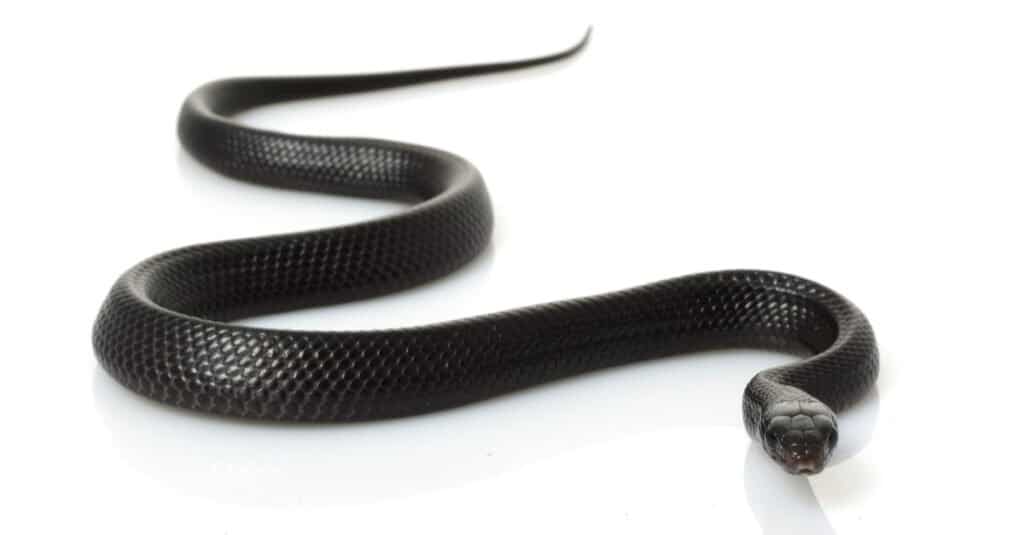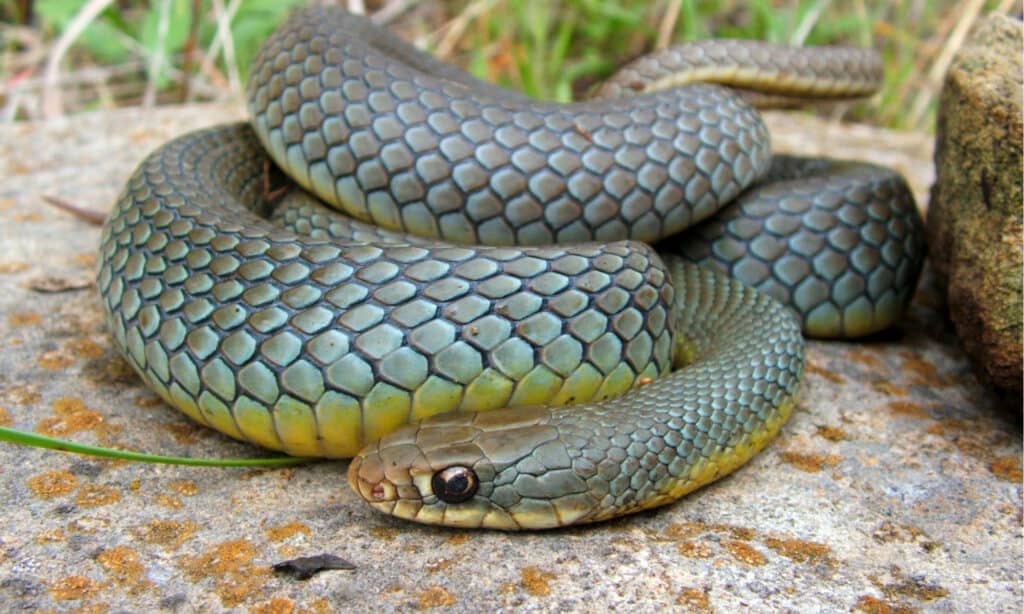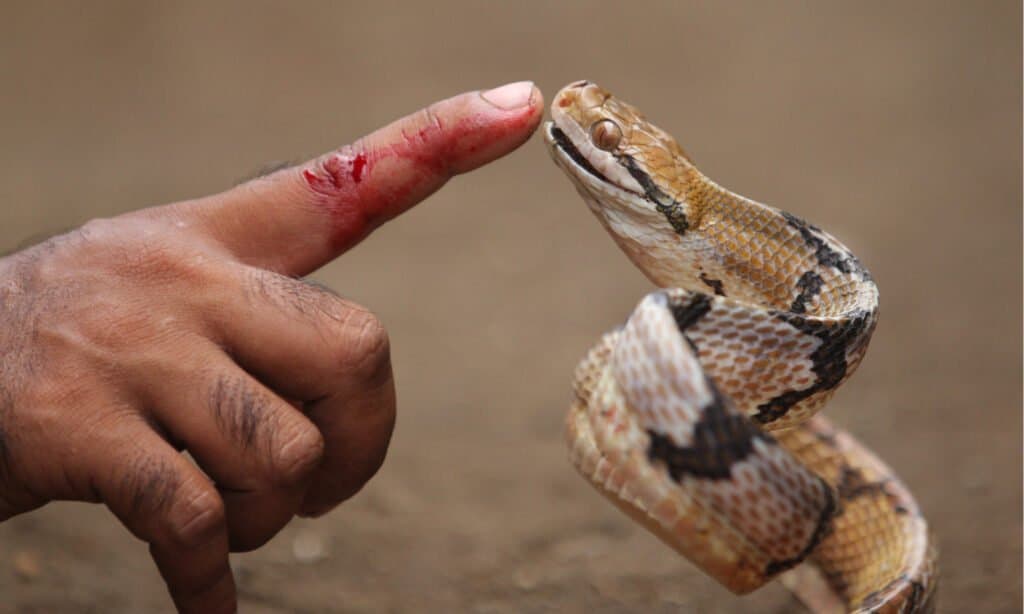Key Points:
- With Texas having more than 100 snake species, it’s not surprising that some of the biggest snakes in America are found there, including this mammoth snake.
- This particular snake breed uses its mass to help overpower its prey.
- When it comes to dealing with snakes, its good to remember to be calm (even if you’re bitten!) and slowly move away from them.
Texas is home to an outstanding 105 species of snakes! It is thought to be the state with the most species of snakes in the entire USA. Many of Texas’s snakes are unique for various reasons. Texas’s copperheads such as the eastern copperhead (Agkistrodon contortrix), broad-banded copperhead (Agkistrodon laticinctus), and the Trans-Pecos copperhead (Agkistrodon contortrix pictigaster) often freeze when spotted in hopes of not being seen.
The rat snake, another Texas snake, rattles its tail like a venomous rattlesnake in hopes of tricking anyone who sees it into believing that it is more dangerous than it is. However, one Texas snake species is famous for a unique reason: its insane length. Let’s take a dive and discover the biggest snake ever found in Texas.
What Is the Biggest Snake Ever Found in Texas?

The biggest snake ever discovered in Texas was an 8.5 feet Texas indigo snake.
©Joe Farah/Shutterstock.com
According to multiple reports, the biggest snake ever discovered in Texas was an 8.5 feet Texas indigo snake. Not much information was provided about this record. However, considering the Texas indigo snake’s average length, the claim is a believable one.
Texas Indigo Snake (Drymarchon melanurus erebennus)

Texas indigo snakes are diurnal predators.
©Joe Farah/Shutterstock.com
Texas indigo snakes (Drymarchon melanurus erebennus) are native to Texas and Mexico. They are molted snakes that grow between 5.5 and 6.5 feet in length. It is safe to say that they are long snakes in general. Texas indigo snakes are active during the day, making them diurnal predators.
Most snakes kill through venom or constriction but indigo snakes do not. During the day, they hunt down prey and kill them by overpowering them. They do this by clamping them in their strong jaws and biting down until their prey is subdued. Texas indigo snakes are known to go for animals that are many times their size. They are not picky eaters either. They eat anything from amphibians and reptiles to small mammals and even venomous snakes. An indigo snake specimen was once found with mice, toads, and juvenile snapping turtles in its belly.
Female Texas indigo snakes can lay up to 12 eggs at a time but sometimes, as little as three. They lay their eggs about 1 month after mating during the winter and early spring. Female indigo snakes are picky about where they lay their eggs. They search for underground burrows where they incubate their eggs. Newly hatched indigo snakes are usually between 14 and 18 inches in length but can be up to 24 inches long on occasion.
How Long Do Texas Indigo Snakes Live?
These huge snakes can live up to 9 years in the wild. It may be surprising, but reptiles on average live longer than mammals of similar sizes. Some scientists have claimed that their cells don’t appear to show signs of aging as dramatically as other animals.
Are Texas Indigo Snakes Venomous?

Texas indigo snakes are nonvenomous colubrid snakes.
© Copyright krs10ellington some rights reserved (CC-BY-NC) – License
Texas indigo snakes are nonvenomous colubrid snakes. However, despite this, they attack, kill, and eat venomous snakes. They are said to have built a tolerance to rattlesnake venom- just like ground squirrels. Though they lack venom in their bites, these snakes are not harmless or defenseless. They are known to bite painfully if they feel threatened.
How to Identify Texas Indigo Snakes
Texas indigo snakes have dorsal stripes that are mostly colored black. They typically have pink underbellies and grow to an average of 6 ft (1.8 m) long.
Where Are Texas Indigo Snakes Found in Texas?
Texas indigo snakes are found around grassland water areas located in southern Texas. They have also been spotted at the Edwards Plateau in western-Central Texas.
Is the Indigo Snake Protected in Texas?
In the state of Texas, the indigo snake is protected. This means that they cannot be hunted or killed.
Are Indigo Snakes and Black Racers the Same?
Black racers are long and slender colubrid snakes that have no venom. They are not the same as indigo snakes. Racer snakes move much faster than indigo snakes, hence their name.
Are Indigo Snakes Aggressive?
Although these snakes aren’t naturally aggressive, they attack aggressively when they hunt or defend themselves. They avoid human contact and can react extremely violently if cornered.
Can Indigo Snakes Be Kept as Pets?

Indigo snakes require a great deal of care in terms of hygiene, accommodation, and diet.
©fivespots/Shutterstock.com
Their lack of venom and beautiful dark scales are qualities likely to make these reptiles a favorite among snake enthusiasts.
However, owing to their status as a protected species, only those bred in captivity may be sold.
Indigo snakes require a significant degree of patience and care. They also require spacious living quarters and a steady diet of small rats and mice.
Indigo snakes also require a temperature gradient in their enclosure as well as fresh drinking water.
Their cages will also need to be cleaned regularly as well.
While indigo snakes may become accustomed to the presence of humans, they may still bite if they feel stressed or ravenous, when handled.
Long Snakes in Texas
Texas is home to some snake species that are close to the indigo snake in length. Let’s take a look:
Bullsnakes

Bullsnakes are one of the largest species in the entire country.
©iStock.com/92968526
Bullsnakes are one of the largest snakes in the entire country, so it’s no shocker that they make this list. They can grow to up to 8 feet and are found in the western two-thirds of the state. They have a color pattern similar to diamondback rattlesnakes’.
Bullsnakes are also called gopher snakes, which they are a subspecies of. If they are threatened, bullsnakes sometimes wave their tails to mimic venomous diamondback rattlesnakes. They are also known to bite aggressively despite their lack of venom.
Yellow-Bellied Racer Snakes

Yellow-bellied racer snakes can run up to 3-4 miles per hour.
©Matt Jeppson/Shutterstock.com
Yellow-bellied racer snakes are known to run up to 3-4 miles per hour. They are also known for being a bit aggressive. They are non-venomous snakes but this doesn’t hinder them from biting painfully if they feel threatened.
What To Do If You Spot A Snake in Texas
If you spot a snake in Texas, the first step you should take should be to exit as calmly as possible. You do not want to agitate or threaten the snake with sudden actions. Your next action should depend on where you spotted the snake.
If you spotted a snake in your home, contact a local snake relocator. Many volunteers do this for free to protect the wildlife. Remember that snakes are an important part of the ecosystem, like all animals, and shouldn’t be killed recklessly. If the snake was spotted outdoors, simply keep your distance and ensure you stay far away.

There are a few myths about snake bites that should not be followed!
©Mufti Adi Utomo/Shutterstock.com
What To Do If You Get Bitten By a Snake in Texas
If you get bitten by a snake in Texas, exit the location and contact emergency services immediately. While you wait, here are some tips to follow.
- Do not attempt to cut off the bitten part. An amputation cannot be reversed and could even worsen the situation. Most snake bites have antivenom treatment.
- Stay calm and do not move around. If you were bitten by a venomous snake, moving around could help the venom circulate.
- Do not attempt to suck the venom out. It could get into your mouth and will probably not come out fully, thus poisoning you in two ways.
Other Reptiles Found in Texas That Are Not Snakes

Green Anoles are commonly found in Texas and Mexico.
©Martin Pelanek/Shutterstock.com
In San Antonio and surrounding Texan areas, a variety of lizards can be spotted, each with unique characteristics. One of these lizards, the Green Anole, has the remarkable ability to change the color of its skin, shifting to a brown hue when circumstances require it to blend into its surroundings.
Here are a few other species of reptiles from Texas that are not snakes:
- Green Anole
- Rosebelly Lizard
- Texas Spiny Lizard
- Texas Alligator Lizard
- Common Spotted Whiptail
- Ground Skink
The photo featured at the top of this post is © Radiant Reptilia/Shutterstock.com
Discover the "Monster" Snake 5X Bigger than an Anaconda
Every day A-Z Animals sends out some of the most incredible facts in the world from our free newsletter. Want to discover the 10 most beautiful snakes in the world, a "snake island" where you're never more than 3 feet from danger, or a "monster" snake 5X larger than an anaconda? Then sign up right now and you'll start receiving our daily newsletter absolutely free.
Thank you for reading! Have some feedback for us? Contact the AZ Animals editorial team.







